|
In 1918 American social scientist Sidney Gamble and two travelling companions sailed
4,000-miles up the Yangtze River into the heart of China. Dressed in stiff white shirts,
bow ties, khaki pants, panama hats and wire-rimmed spectacles, the three foreigners attracted
so much attention that they called themselves the "Great American Three-Ring Circus."
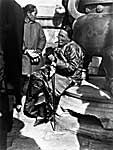 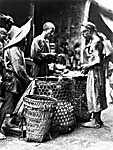 
Gamble, armed with his portable typewriter and bulky Graflex camera, must have been
about as inconspicuous as a green-skinned UFO pilot landing on
Tiananmen Square.
Nevertheless, he managed to take over 1,000 candid photographs documenting native
peoples and customs rarely seen by Westerners.
In photos from the expedition, Gamble's clothes never looked rumpled and his hair was
never unkempt. He carried his camera in a worn leather case with his initials
monogrammed on the outside. He looks a real-life Indiana Jones: a nerdy but fearless
hero voyaging to exotic locales in pursuit of knowledge and adventure.
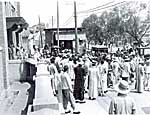
Today, Gamble's Sichuan expedition could be done in a single week on a luxury Yangtze
cruise ship, complete with an official CITS tour guide and nights spent in a Holiday Inn.
Few Chinese would stare anymore; the novelty of seeing big-nosed foreigners has
long-since worn off, and camera-clutching tourists are now commonplace. The Yangtze is
polluted. Most of the villages have grown into dirty, charmless industrial towns. There
are no more junks with their characteristic silhouettes. Trackers, who used to pull boats up
the river by brute force, have been replaced by powerful ship engines.
This sense of loss gives a seductive nostalgia to Gamble's photographs, taken in China
from 1908-1932. Now on display through October 16 at the National Museum of Chinese
History, these images capture the tumultuous historical period between the fall of the Qing
Dynasty (1644-1911) and China's hesitant emergence as a modern nation. China was
still a pre-industrial country with peasants, craftsmen and merchants laboring much as
they had for centuries. Gamble photographed a pre-modern China poised on the edge of
war and revolution.
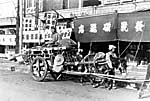
The well-curated exhibit entitled Turbulent Years: China Before and After the May Fourth
Movement, includes 211 images from the Gamble archive of over 5,000 black-and-white
images, accompanied by concise historical and biographical information in both English
and Chinese. Divided thematically into six sections, the exhibit includes images of major
historical events, such as the May 4, 1919 student demonstrations in Tiananmen Square
against the unfair World War I armistice treaty, and the funeral of the father of China's
revolution, Dr. Sun Yat-sen. There are also documentary photographs of the daily life of
Chinese people at work, home and play. The attention paid to the routine activities and
rituals of Chinese life reveals the anthropological and ethnographic
underpinning of Gamble's work, but the artistic power of the images derives from his sympathetic and
humane representation of individual people.
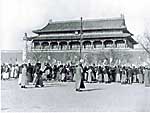
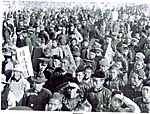
Gamble devoted his academic career to the sociological study of China, writing five books
on the subject. His best known work is Peking: A Social Survey, a
meticulously-researched 500-page study that documents everything from population
statistics, geography, and architecture, to Chinese social life, customs, and religious
observance. At a time when Western scholars had precious little factual or statistical
information about China, Gamble and his team of Chinese researchers tracked the
expenditures and earnings of 283 families from various socio-economic backgrounds in
an attempt to document the diversity of Peking life. Since photography was a life-long
hobby of Gamble's, it was natural for him to use his camera to complement his
sociological research on China. Although he sometimes used his photographs to illustrate
his books, Gamble may not have realized the enduring power and artistic merit of the
images he captured on film. From the time of Gamble's death in 1968 until his eldest
daughter, Catherine Gamble Curran, rediscovered them in 1984, the entire archive of
photographs, negatives and film sat collecting dust in rosewood boxes in a closet on the
third floor of the family home in the US.
Curran has since founded the Sidney D. Gamble Foundation for China Studies to
safeguard her father's photographic and scholarly legacy. (Incidentally, the Foundation's future is a safe bet: Sidney D.'s 'Gamble'
is the very same surname as one of the founding partners of multi-national consumer products giant Proctor and Gamble.)
The Foundation's first exhibition of Gamble's photographs opened at the China
Institute in New York City in 1989 and later traveled to 19 cities in Canada and the US.
The exhibit was enthusiastically received by visitors, including many overseas Chinese.
When Curran saw Chinese grandparents leading their grandchildren through the exhibit to
teach them about the history of their distant homeland, she realized that to complete her
father's intellectual and artistic work she would have to bring her father's photographs
back to the country and people that had inspired them. Poor relations between the United
States and China during the Cold War prevented Gamble himself from returning to China
before his death.
In 1993, Curran began the long process of locating a venue in China to stage an exhibit.
The Gamble Foundation collaborated with the private Beijing Haiyin Arts and Culture
Company to curate the show for a Chinese audience and secure the necessary permits.
Hai Di, the director of the Haiyin Company, expressed her desire to hold the show during
the 50th anniversary celebrations as a "birthday gift to our motherland."
Although the Sino-US collaboration on the staging of the exhibit would probably have
pleased the late Sidney Gamble, navigation of the Chinese bureaucracy was not always
so smooth. In May 1999, with the approval of the Ministry of Culture and the Ministry of
Arts and Artifacts in hand, the Museum of Chinese History agreed to provide the gallery
space. One bureaucratic hurdle remained - the final permit could only be applied for from the Public Security
Bureau 30 days before the event was scheduled to open. In the
atmosphere of pre-50th anniversary-tension and 33 days before the Gamble exposition
was set to open, the PSB announced that they would no longer issue permits for activities
being held at Tiananmen Square. Final permission would have to be obtained from the
Central Committee of the Communist Party. The Haiyin Company must have paid for
some expensive dinners: intensive guanxi-pulling resulted in eleventh hour permission to
open the show.
What Curran and the Haiyin Company have succeeded in bringing to China at the
symbolic center of the nation for the 50th anniversary is nothing less than a piece of their
own past. In a capital city where the breakneck pace of change leaves urban mapmakers
reeling, not much of turn-of-the-century Peking remains. And in a country where history
is considered elastic and is thus subject to almost constant revision according to the current
ideological climate, Gamble's photographs are a document made by an outside observer
of China with little political or didactic intent. Stark images of poverty, prisoners and
child laborers hang next to photographs of the Forbidden City and festivities at Beijing's Lama
Temple. On the opening day of the exhibition, a horde of high school students clad in blue
and white track suit uniforms point at photos of familiar places in Beijing and chat noisily.
Though the museum visit is part of their patriotic history education, these students get
a glimpse of China's past through a relatively unbiased lens.
Turbulent Years: China Before and After the May Fourth Movement is at the National
Museum of Chinese History in Tiananmen Square through October 16, Daily 9 am-5 pm,
Tel: 6512-8321 |









